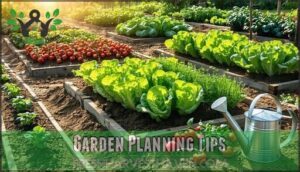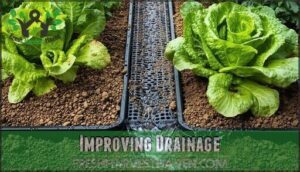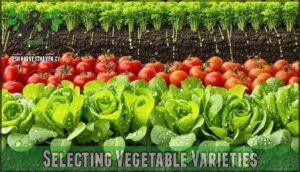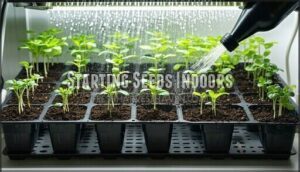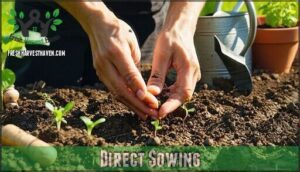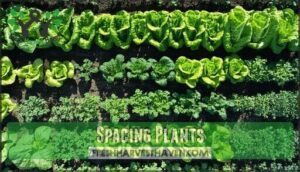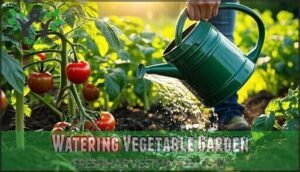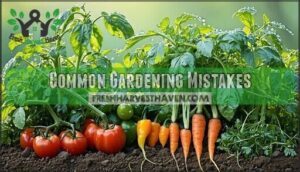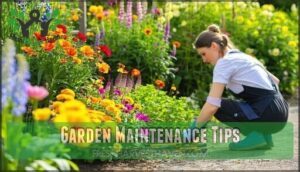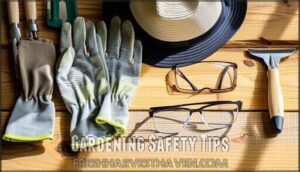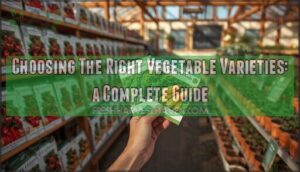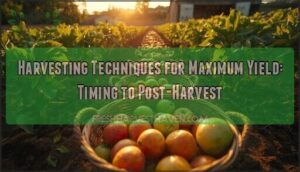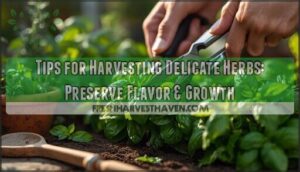This site is supported by our readers. We may earn a commission, at no cost to you, if you purchase through links.
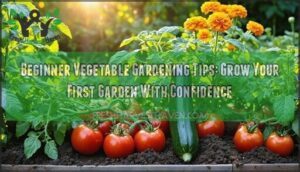
Choose a spot with good sunlight, and select easy-to-grow veggies like tomatoes or zucchini.
Prepare your soil by adding organic matter, and consider companion planting to boost growth.
Don’t overwater, and keep your garden well-maintained.
With these basics covered, you’ll be harvesting fresh produce in no time – and that’s just the beginning of your gardening journey, with plenty more to learn and discover about growing your own delicious vegetables.
Table Of Contents
- Key Takeaways
- Starting Vegetable Garden
- Garden Planning Tips
- Soil Preparation Methods
- Selecting Vegetable Varieties
- Planting Vegetable Garden
- Watering Vegetable Garden
- Common Gardening Mistakes
- Garden Maintenance Tips
- Harvesting Vegetables
- Gardening Safety Tips
- Frequently Asked Questions (FAQs)
- Why should a beginner start a vegetable garden?
- How to start a vegetable garden?
- How do I choose the perfect spot for my beginner vegetable garden?
- How do I start a garden as a beginner?
- What are the best vegetable gardening tips?
- How do I learn vegetable gardening?
- What is the easiest vegetable to grow for a beginner?
- What is the most common mistake of first time gardeners?
- How to start a vegetable garden for beginners step by step?
- Which vegetables should not be planted next to each other?
- Conclusion
Key Takeaways
- You’ll want to choose a spot with good sunlight and prepare your soil by adding organic matter to create a nutrient-rich environment for your veggies to thrive.
- Don’t overwater – it’s a common mistake that can lead to root rot and poor plant growth, so make sure to check soil moisture regularly and water wisely.
- You should select easy-to-grow veggies like lettuce, radishes, and green beans, which are perfect for beginners and can help you build confidence in your gardening skills.
- Remember to plan your garden layout carefully, considering factors like plant spacing, companion planting, and crop rotation to ensure a healthy and productive garden that’ll provide you with a bountiful harvest.
Starting Vegetable Garden
You’re about to start your own vegetable garden, so let’s get the basics right—pick a spot with good sunlight, choose easy vegetables like lettuce and beans, and make sure your soil is loose and rich.
Don’t worry if your carrots end up a little crooked; even the pros have a few funny-looking veggies now and then, and it’s all part of the experience of growing your own vegetable garden.
Growing your own veggies is all about embracing the journey, imperfections and all
Choosing Plot Size
When sizing up your beginner garden, think about space requirements and how much time you can spare—that 10×10-foot plot isn’t as tiny as it sounds.
Family size and yield expectations should steer your garden planning, consider optimal garden dimensions for efficient planting, which can be found at optimal garden dimensions.
Start with a manageable garden size, then expand as your confidence grows, it’s easier to manage a smaller plot before growing into a serious green thumb.
Selecting Easy Vegetables
Now that you’ve picked your garden plot size, let’s talk about beginner friendly easy vegetables.
Choosing plants for your beginner garden doesn’t have to be hard. Here are some easy vegetables to get you started:
- Radishes: Quick to grow, high yield.
- Lettuce: Space savers, cut-and-come-again harvests.
- Green Beans: Pest resistance, reliable producer.
Consider climate suitability and family favorites during vegetable selection. Many vegetables need six hours sunlight for ideal growth.
These beginner tips will set you up for success!
Preparing Soil
Great vegetable choices set the foundation, but your soil quality determines success.
Test your soil pH (aim for 6.0-7.0) and add compost to boost soil nutrients.
Different soil types need specific amendments – sandy soils benefit from organic matter retention, while clay soils require better drainage.
Proper soil aeration through gentle tilling creates the nutrient-rich soil your plants crave.
Garden Planning Tips
Creating a well-thought-out garden layout sets the foundation for your vegetable growing success.
Plan your garden layout for a thriving and successful harvest
You’ll want to take into account plant spacing, companion relationships, and rotation schedules that keep your soil healthy and productive year after year.
Creating Garden Layout
Once you’ve chosen your plot size and vegetables, it’s time to sketch your garden blueprint. Think of it like arranging furniture in a room – you want everything to flow smoothly while maximizing your space.
Here’s your garden planning checklist:
- Path Placement – Create 2-foot walkways every 4 feet so you can reach plants without stepping on soil
- Planting Patterns – Use triangular spacing and odd numbers (3, 5, 7) for better visual appeal and higher yields
- Maximize Space – Try wide rows and block planting instead of single file rows
- Sunlight Needs – Place tall plants on the north side to prevent shading shorter crops
- Consumption Planning – Group heavy producers together and plan realistic portions for your family’s eating habits
Companion Planting
Looking at companion planting, you’ll discover nature’s perfect partnerships for vegetable gardening success.
Smart companion planting combines Growth Enhancement with natural Pest Deterrents, creating healthier gardens through strategic plant placement.
Aromatic Herbs like basil protect tomatoes while attracting beneficial insects for Pollinator Attraction.
This garden planning technique promotes Resource Sharing between plants, improving soil preparation and pest control naturally without chemicals.
Polyculture, or growing diverse plants together, can further enhance these benefits.
Crop Rotation
Crop rotation prevents soil depletion and pest buildup by changing plant families in each garden bed annually.
This simple vegetable gardening technique maintains soil health while providing natural pest control.
Plan your rotation by grouping vegetables into families—tomatoes, beans, and brassicas shouldn’t return to the same spot for three years.
Smart rotation planning maximizes nutrient management and garden productivity.
Soil Preparation Methods
You’re getting ready to prepare your soil, which is a vital step in growing a healthy and thriving vegetable garden.
By following the right soil preparation methods, you’ll be able to create an ideal environment for your plants to grow, with the right balance of nutrients, drainage, and moisture. Complete concepts help with soil preparation.
Adding Organic Matter
Now that you’ve planned your garden, let’s enrich your soil. Adding organic matter is key, it’s like giving your plants a super boost. Think of organic matter as a fantastic soil amendment.
Here’s how to get started:
- Use compost, for compost benefits.
- Consider manure types, like well-rotted manure.
- Try green manure, a great organic gardening trick.
Your nutrientrich soil will thank you, and so will your plants. Soil microbes will love it too! For ideal results, understand the soil decomposition process to create a fertile ground. Adding organic matter is a crucial step in this process.
Improving Drainage
When planting, make certain good soil drainage to prevent waterlogged soil.
Use soil amendments, French drains, or raised beds to improve drainage. Permeable paving and drainage pipes can also help.
Proper drainage is key to successful vegetable gardening, so don’t overlook this vital step to avoid common mistakes, as it is crucial for successful vegetable gardening.
Selecting Vegetable Varieties
You’re now ready to select the perfect vegetable varieties for your garden, considering factors like ease of growth, productivity, and your family’s preferences.
By choosing the right varieties, you’ll set yourself up for a successful and enjoyable gardening experience, so let’s get started with some tips and recommendations.
Easy-to-Grow Vegetables
You’re starting vegetable gardening, begin with easy vegetables like lettuce, radishes, and green beans, which are fast-growing and low-maintenance, perfect for beginners.
They are great for container options, making them kid-friendly veggies too.
Productive Varieties
When you’re planning your garden, smart variety selection can make or break your harvest success.
High-Yield Cultivars like cherry tomatoes and Swiss chard keep producing all season long, while Disease-Resistant Types help beginners avoid common pitfalls.
Consider these productive options for maximum return on your gardening investment:
- Space-Saving Varieties: Bush beans and compact lettuce varieties maximize small garden productivity
- Fast Growing: Radishes and leafy greens provide quick harvests in just 25-30 days
- Climate-Specific Options: Choose varieties suited to your hardiness zone for better success rates
- Heirloom vs. Hybrid: Hybrids often offer better disease resistance and consistent yields for beginners
Easy vegetables like these easytogrow varieties fit perfectly into any planting schedule, giving you confidence as you build your gardening skills.
Family Preferences
Beyond just picking vegetables you’ll grow, you need to take into account what your family actually eats.
Survey everyone’s taste preferences and dietary restrictions before making your garden plant selection. Kid-friendly veggies like cherry tomatoes and snap peas often become gateway vegetables for reluctant eaters.
| Consideration | Garden Impact |
|---|---|
| Cultural Dishes | Grow herbs and vegetables for traditional family recipes |
| Dietary Restrictions | Choose gluten-free, low-sodium, or allergen-free varieties |
| Taste Preferences | Plant sweet varieties for picky eaters, spicy for adventurous palates |
| Family Involvement | Select easy-to-grow vegetables that children can help tend |
| Planting Schedule | Match vegetable varieties to your family’s seasonal eating habits |
Planting Vegetable Garden
Once you’ve prepared your garden space and selected your vegetables, it’s time to get those seeds and seedlings into the ground.
Whether you’re starting seeds indoors for a head start or sowing directly in your garden, proper planting techniques set the foundation for a successful harvest.
Starting Seeds Indoors
With seed starting, you can get a head start on the growing season. Begin by sowing seeds indoors six to eight weeks before the last expected frost. Use a quality Seed Starting Mix, not garden soil types.
Many gardeners find pre-mixed options convenient.
- Maintain adequate Indoor Humidity Levels.
- Consider Seedling Heat Mats for warmth.
- Make proper Grow Light Selection.
- Remember Hardening Seedlings before transplanting.
High seed quality and correct planting times are key.
Direct Sowing
You’re now ready to try direct sowing, where seeds are planted straight into the garden.
Check seed quality, planting times, and soil temperature for ideal germination rates.
Then water seedlings gently, considering seed depth and sunlight for successful growth.
Spacing Plants
You’re now considering plant spacing.
Leave enough space for ideal density, airflow needs, and sunlight access.
Check the plant size to avoid root competition, ensuring easy-to-grow vegetables thrive in your garden, following garden planting guidelines for perfect vegetable gardening, with a focus on ideal density.
Watering Vegetable Garden
You’re now ready to learn about watering your vegetable garden, a vital step in keeping your plants healthy.
As you water, you’ll want to focus on the soil, not the leaves, to prevent fungal issues and make certain your plants get the moisture they need.
Watering Techniques
Let’s talk watering techniques. Proper irrigation keeps your garden happy. You’ll want to water deeply and less frequently, encouraging strong roots.
Check soil moisture before watering; it’s like giving your plants a drink only when they’re thirsty! Efficient irrigation saves water and keeps your plants healthy.
Mulching around plants can reduce evaporation by up to 70%.
Here are some watering tips:
- Water early in the morning.
- Use a watering can or soaker hose.
- Focus on the base of the plant.
- Consider water conservation.
Efficient irrigation techniques, including proper irrigation, are crucial for a healthy garden, and by following these tips, you can create a thriving environment for your plants, which will be happy with deeply watered soil.
Avoiding Overwatering
You’re watering your garden, now beware of overwatering, which can cause Root Rot.
Check Soil Moisture regularly to determine Watering Frequency, ensuring proper Drainage Solutions for your plant’s needs.
| Soil Types | Watering Tips | Drainage |
|---|---|---|
| Clay | Less often | Improve drainage |
| Sandy | More often | Retain moisture |
| Loamy | Balanced | Natural drainage |
The key to successful gardening is understanding the specific needs of your plants, including Soil Moisture and Drainage Solutions.
Mulching Benefits
You’ll love mulching, it helps with weed suppression, moisture retention, and temperature regulation.
Mulching also aids in soil enrichment and erosion control, making it a great garden maintenance technique.
By adding organic matter, you’ll improve soil health and reduce the need for weed control, making gardening easier.
Common Gardening Mistakes
You’re probably excited to start your garden, but it’s easy to make mistakes that can hurt your plants.
By being aware of common errors like overwatering, insufficient sunlight, and not rotating crops, you can take steps to avoid them and grow a healthy, thriving garden.
Overwatering Plants
You risk root rot by overwatering, so check soil moisture.
Adjust watering frequency to prevent plant diseases, monitoring plant symptoms and garden soil moisture for ideal plant health, using drainage solutions for better soil aeration to ensure complete concepts of plant care are understood.
Insufficient Sunlight
You’ll want to make certain your garden gets enough sunlight.
Choose shade tolerant plants or use artificial lighting if necessary.
Consider reflective surfaces for sunlight maximization.
If not, garden relocation might be needed to meet garden sunlight requirements, avoiding garden plant shading based on planting location.
Not Rotating Crops
You’re making progress, but not rotating crops can lead to soil depletion, pest buildup, and disease spread, causing nutrient imbalance and reduced yields in your vegetable gardening journey.
Affecting companion planting and overall garden health is a critical aspect of gardening, as it can lead to various issues if not properly managed.
Garden Maintenance Tips
You’re now ready to learn about garden maintenance tips, which will help you keep your garden healthy and thriving.
By following these tips, you’ll be able to fertilize and prune your plants effectively, ensuring a bountiful harvest from your vegetable garden.
Fertilizing Plants
Even if you’re just starting out, your plants need nutrition.
Soil testing can reveal what’s missing, and help you dial in fertilizer ratios—too much or too little, and you’ll spot deficiency symptoms like yellow leaves.
Stick with a fertilizing schedule and alternate organic fertilizers and synthetic nutrients for balanced plant nutrition. Remember, healthy soil nutrients mean happy veggies!
Pruning Plants
Sharp pruning shears become your garden’s best friend when managing vegetable plants. Regular trimming promotes healthier growth and increases yields by directing energy to fruit production rather than excess foliage.
Fall is also a good time to address tree and shrub care for winter survival.
- Remove suckers from tomato plants weekly to focus energy on main stems
- Trim lower leaves touching soil to prevent disease spread through watering
- Prune damaged or yellowing leaves immediately to maintain plant health
- Cut herbs frequently to encourage bushier growth and extend harvesting season
Harvesting Vegetables
You’re getting close to enjoying the fruits of your labor, and harvesting vegetables is an exciting part of the gardening process.
Now that your plants have grown, you’ll need to figure out when to pick them, how to store them, and ways to preserve your harvest for later use, which is a crucial step in the gardening process.
Harvest Timing
Successful harvest timing is key to enjoying peak ripeness. Use visual cues like color and size to guide you.
Don’t be afraid of taste testing! A staggered harvest, or extending season, guarantees a continuous supply.
Good harvest management means knowing when to pick. Here are some harvesting tips:
:
——–
:
——————-
:
——————–
Storage Techniques
You’ve mastered harvest timing, now store your homegrown vegetables properly.
Keep leafy greens cold, sealed, and unwashed for ideal conditions.
Root vegetables should be stored in a cool, dark place to extend shelf life, using suitable container types for each.
Preserving Harvest
You’re harvesting vegetables, now preserve them.
- Freezing Vegetables
- Canning Techniques
- Drying Herbs
- Pickling Recipes, to enjoy gardenfresh flavors year-round, and make the most of your homegrown vegetables, using methods like Root Cellaring.
To maintain quality, consider morning harvest benefits and use these methods to enjoy your harvest, with key preservation techniques.
Gardening Safety Tips
While gardening brings joy and fresh produce to your table, it’s important to stay safe while tending your plants.
From choosing the right location to using proper protective gear, these safety measures will help you enjoy your garden without unnecessary risks.
Garden Location Safety
When choosing your garden spot, prioritize safety alongside sunlight and drainage needs.
Select locations with gentle slopes for proper water flow while ensuring garden accessibility through well-maintained paths.
Consider wind protection from structures or natural barriers, and evaluate garden local conditions including proximity to your home for easy monitoring.
| Safety Factor | Consideration | Action |
|---|---|---|
| Safe Pathways | Level ground, proper width | Create 2-3 foot wide paths between beds |
| Water Safety | Drainage, standing water | Choose sloped areas, avoid low spots |
| Sun Exposure | 6-8 hours daily light | Monitor shade patterns throughout day |
| Chemical Storage | Secure location nearby | Install locked cabinet away from children |
| Pest Control | Natural barriers, fencing | Use companion plants, physical barriers |
Tool Maintenance
Well-maintained garden tools make your gardening experience safer and more enjoyable.
Clean tools after each use to prevent disease spread and keep them sharp for efficient cutting.
- Cleaning methods: Scrub dirt off with soap and water, then dry thoroughly
- Sharpening techniques: Use a file or whetstone on blades monthly during growing season
- Storage solutions: Hang tools in a dry shed or garage to prevent rust formation
Regular garden tool maintenance extends their lifespan and guarantees they’re ready when you need them most.
Personal Protective Gear
A single garden adventure can turn pesky without the right gear.
Eye protection keeps flying garden pests out of your eyes, while gloves give unbeatable hand protection against thorns and garden diseases.
Choose sun protection hats and long-sleeve clothing for comfort.
When using dusty gardening tools, wear a mask for respiratory safety.
| Must-Have Gear | Why You Need It |
|---|---|
| Gloves | Thorns & disease guard |
| Hat & Sleeves | Sun protection matters |
| Goggles & Mask | Debris & dust defense |
Frequently Asked Questions (FAQs)
Why should a beginner start a vegetable garden?
What’s holding you back? You’ll enjoy fresh produce, a sense of accomplishment, and outdoor activity, making starting a vegetable garden a remarkably rewarding experience for you.
How to start a vegetable garden?
You’ll start by preparing the soil, selecting easy-to-grow vegetables, and creating a garden layout that suits your space and climate, then plant and maintain your garden regularly.
How do I choose the perfect spot for my beginner vegetable garden?
Imagine your garden as a sunny haven, you’ll choose a spot with plenty of sunlight, good drainage, and access to water, making it perfect for your vegetables to thrive.
How do I start a garden as a beginner?
You’ll begin by selecting easy-to-grow vegetables, preparing well-draining soil, and creating a simple garden layout to guarantee a successful and enjoyable gardening experience.
What are the best vegetable gardening tips?
You’ll thrive by choosing easy-to-grow veggies, preparing well-draining soil, and watering wisely, setting yourself up for a bountiful harvest and a fun gardening experience.
How do I learn vegetable gardening?
You learn vegetable gardening by reading guides, watching tutorials, and practicing with easy-to-grow vegetables like lettuce and radishes, then expanding your skills and knowledge over time.
What is the easiest vegetable to grow for a beginner?
You’ll find lettuce is a great symbol of ease, as it’s one of the easiest veggies to grow, requiring minimal care and maturing quickly, making it perfect for you.
What is the most common mistake of first time gardeners?
You often overwater or underwater, forgetting to test soil moisture, which can lead to root rot, nutrient deficiencies, and poor plant growth, so check it regularly.
How to start a vegetable garden for beginners step by step?
Like a puzzle, start by planning your garden, choosing the right vegetables, and preparing the soil, then plant, water, and maintain, and you’ll be harvesting in no time, easily.
Which vegetables should not be planted next to each other?
You shouldn’t plant beans near onions, beets, or cabbage, and avoid placing tomatoes near brassicas, like broccoli, to prevent growth issues and pest attraction in your garden.
Conclusion
Freshly following these beginner vegetable gardening tips, you’ll fearlessly foster a fantastic garden.
By focusing on fundamentals, you’ll find that growing your own veggies is fairly straightforward.
Remember, beginner vegetable gardening tips are key to a successful harvest, so don’t be afraid to try new things and learn as you go.
- https://www.homedepot.com/c/ah/how-to-start-a-vegetable-garden/9ba683603be9fa5395fab90d6de2854
- https://hort.extension.wisc.edu/articles/beginning-vegetable-garden-basics-site-selection-and-soil-preparation/
- https://www.seedsofchange.com/articles-and-videos/how-to-prepare-your-soil
- https://ucanr.edu/site/uc-master-gardeners-santa-clara-county/vegetable-gardening-basics
- https://www.thespruce.com/how-often-should-you-water-your-vegetable-garden-11752116

